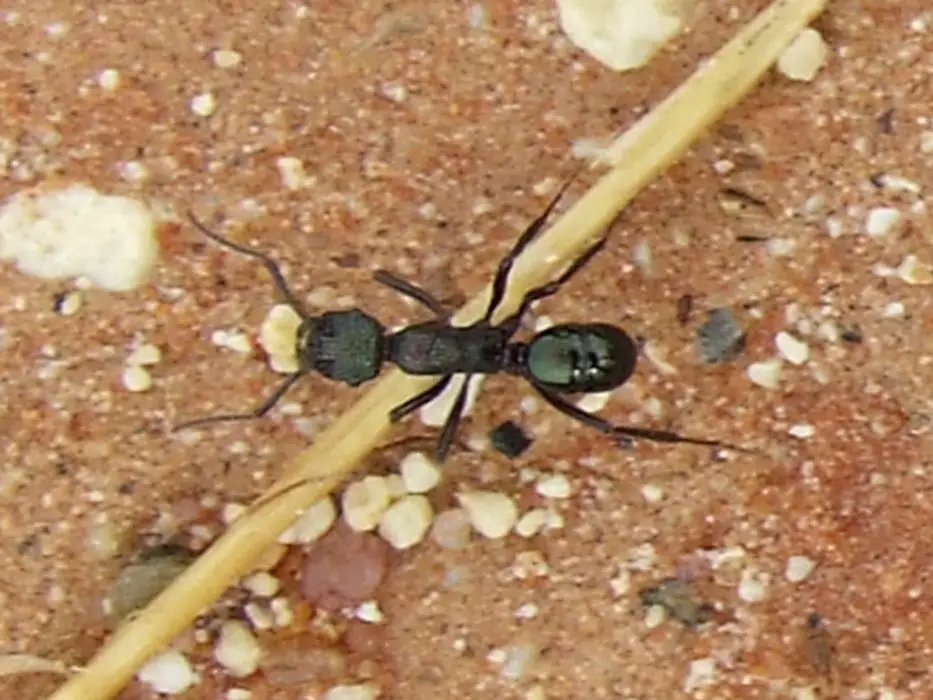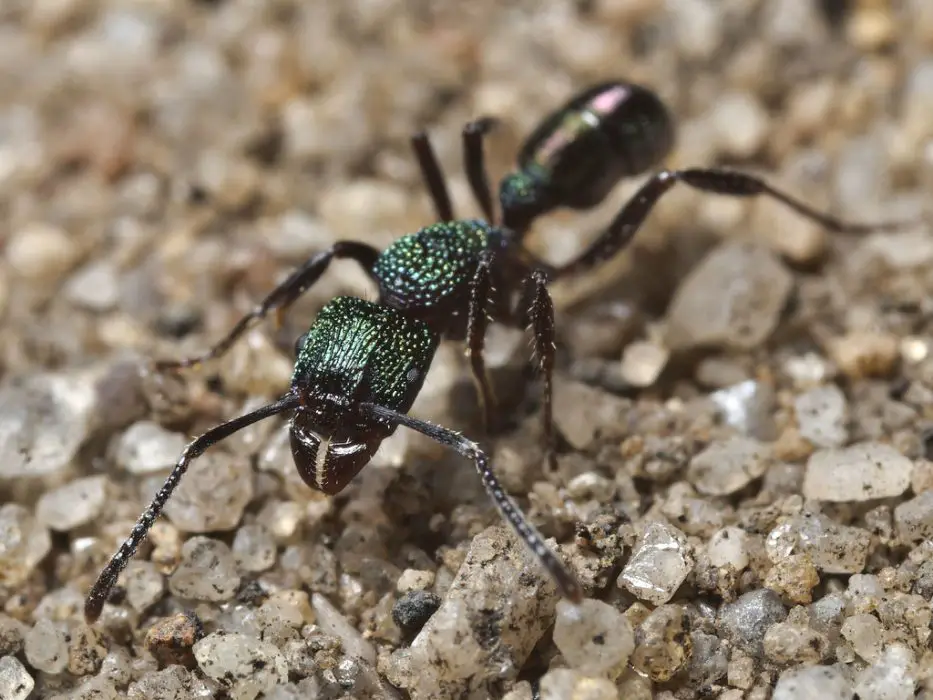Have you ever spotted a dazzling ant, its head shining with a radiant green hue? Enter the realm of the Green-head ants, nature’s gleaming marvel.
Sporting a distinctive metallic-green crown, this ant doesn’t merely rely on its allure. Instead, they actively forage, navigating their terrain with skill and determination. As you watch, their movements showcase a dance of purpose and intent.
Beyond their striking appearance, there’s a world of intricate communication and defined roles within their colonies. They work seamlessly together, ensuring the survival and prosperity of their community. So, as we peel back the layers of their existence, we discover not just beauty but also tales of resilience, unity, and the captivating rhythm of nature. Are you eager to discover what lies beneath?
What do Green-Head Ants look like?
Green-Head Ants Appearance:
- Color: Showcasing a vivid metallic-green head and thorax, these ants command attention, shimmering uniquely amidst foliage and soil.
- Body: Their sleek, slender bodies are a testament to nature’s design, reflecting both elegance and functional efficiency, tailor-made for their bustling ant activities.
- Size: Measuring between 6 to 7 millimeters, their size is moderate but distinct, making them noticeable without being too imposing in the vast ant world.
- Abdomen/Gaster: While their heads gleam with green, the abdomen offers a contrast, adopting a deep blackish or dark brown hue, which provides them with an interesting dichotomy in appearance.
- Other Features: Their robust mandibles are more than just tools; they’re a symbol of their resilience, allowing them to tackle varied terrains and tasks. Meanwhile, their long, pronounced antennae serve as intricate sensory devices, capturing even the faintest of signals in their environment.
The harmonious blend of their metallic sheen, coupled with the radiant green, doesn’t merely make them distinguishable; it underscores the vibrant diversity of the insect kingdom.
Green-Head Ant queen
The Green-Head Ant queen, found on Australia’s east coast, possesses a potent sting capable of causing anaphylactic shock in sensitive individuals. These solitary nesters establish homes in the ground or beneath rocks.
They maintain monogamous behavior, mating only once in their lifetime with a single male while continuously laying eggs, leading to colony expansion. All workers in Green-Head Ant colonies are of the same size, a characteristic known as monomorphism.
These queens play crucial roles in the ecosystem, controlling insect populations and serving as food sources for birds and lizards. They exhibit impressive traits, such as a lifespan of up to 10 years and the ability to lay up to 100 eggs daily, allowing colonies to grow beyond 100,000 workers.
What Do Green-Head Ants Eat?

Green-head ants are also known as Rhytidoponera metallica have a diverse diet that includes:
- Insects and Arthropods: Green-head ants are opportunistic scavengers. They actively forage for and feed on a variety of dead insects and arthropods. This scavenging behavior helps keep their colonies well-fed and sustains their nutritional needs.
- Predatory Behavior: In addition to scavenging, these ants exhibit predatory behavior when the opportunity arises. They may capture and consume smaller insects and other creatures that they can overpower.
- Consumption of Sweet Substances: Green-head ants also have a preference for sweet substances. They are known to feed on honeydew, a sugary secretion produced by aphids and certain other sap-sucking insects. These ants establish mutualistic relationships with aphids, protecting them from predators in exchange for a steady supply of honeydew.
Their dietary versatility, which includes scavenging, predation, and consumption of sweet substances, underscores their adaptability and ability to thrive in a range of ecological niches. This adaptability is crucial for their survival, particularly in environments where food resources can be scarce and unpredictable.
Where Do Green-Head Ants Live?
Enter the enchanting world of Green-Head Ants, where nature’s wonders unfold. Discover their habitat preferences and lifestyle in the concise bullet points below, as we unveil the secrets of these remarkable creatures.
- Habitat: Green-head ants primarily reside in forested regions across Australia.
- Preference: They favor areas with substantial ground cover, leaf litter, and decaying wood.
- Nest Construction: These ants actively create nests within the soil, beneath rocks, or under logs, establishing a complex network of tunnels and chambers.
- Protection and Access: Their choice of habitat provides protection and easy access to a wide range of prey and food sources found in these forested ecosystems.
- Adaptability: Green-head ants showcase adaptability, allowing them to thrive in various regions of Australia.
Do Green Head Ant Bites?
Yes, Green-Head Ants can indeed deliver a bite, and it’s natural to wonder if these bites are dangerous and how they should be treated.
Firstly, Green-Head Ants are not known for being particularly aggressive towards humans. They typically bite when they feel threatened or if their nest is disturbed. When they do bite, it can result in a sharp, localized pain, similar to a nip.
However, the good news is that Green-Head Ant bites are generally not considered dangerous to humans. While the pain can be uncomfortable, their bites are not known to cause severe harm or transmit diseases.
In terms of treatment, if you’ve been bitten by a Green-Head Ant, it’s essential to clean the affected area with mild soap and water to prevent infection. Applying an antiseptic can also help. Over-the-counter pain relievers can alleviate discomfort, and if you experience any signs of an allergic reaction or infection, it’s advisable to seek medical attention.
How to Get Rid Of Green-Head Ants?
To effectively eliminate Green-Head Ants, follow these steps:
Identify the Infestation: Confirm the presence of Green-Head Ants for precise action.
Remove Food Sources: Keep your home clean and store food in sealed containers to deny ants access.
Seal Entry Points: Close gaps and openings around your home to prevent ant entry.
Apply Natural Repellents: Utilize substances like diatomaceous earth or lemon juice at entry points to deter ants.
Utilize Bait Stations: Deploy commercial ant bait stations to disrupt the colony and eliminate ants.
Consult Professionals: If the infestation persists, seek expert pest control assistance.
Regularly Monitor: Keep an eye out for ant activity and act swiftly if detected.
By taking proactive measures and adhering to these steps, you can actively remove Green-Head Ants from your premises and maintain a pest-free environment.
Conclusion
In conclusion, Green-Head Ants, with their striking appearance and diverse diet, reveal a world of natural wonder and adaptability. While they can deliver bites when provoked, they are generally not considered dangerous to humans. Effective control measures involve identifying the infestation, removing food sources, and sealing entry points.
Natural repellents and bait stations can be valuable tools. If needed, consulting pest control professionals ensures comprehensive eradication. By remaining vigilant and proactive, you can successfully manage Green-Head Ants and enjoy a pest-free environment, celebrating the marvels of nature.



